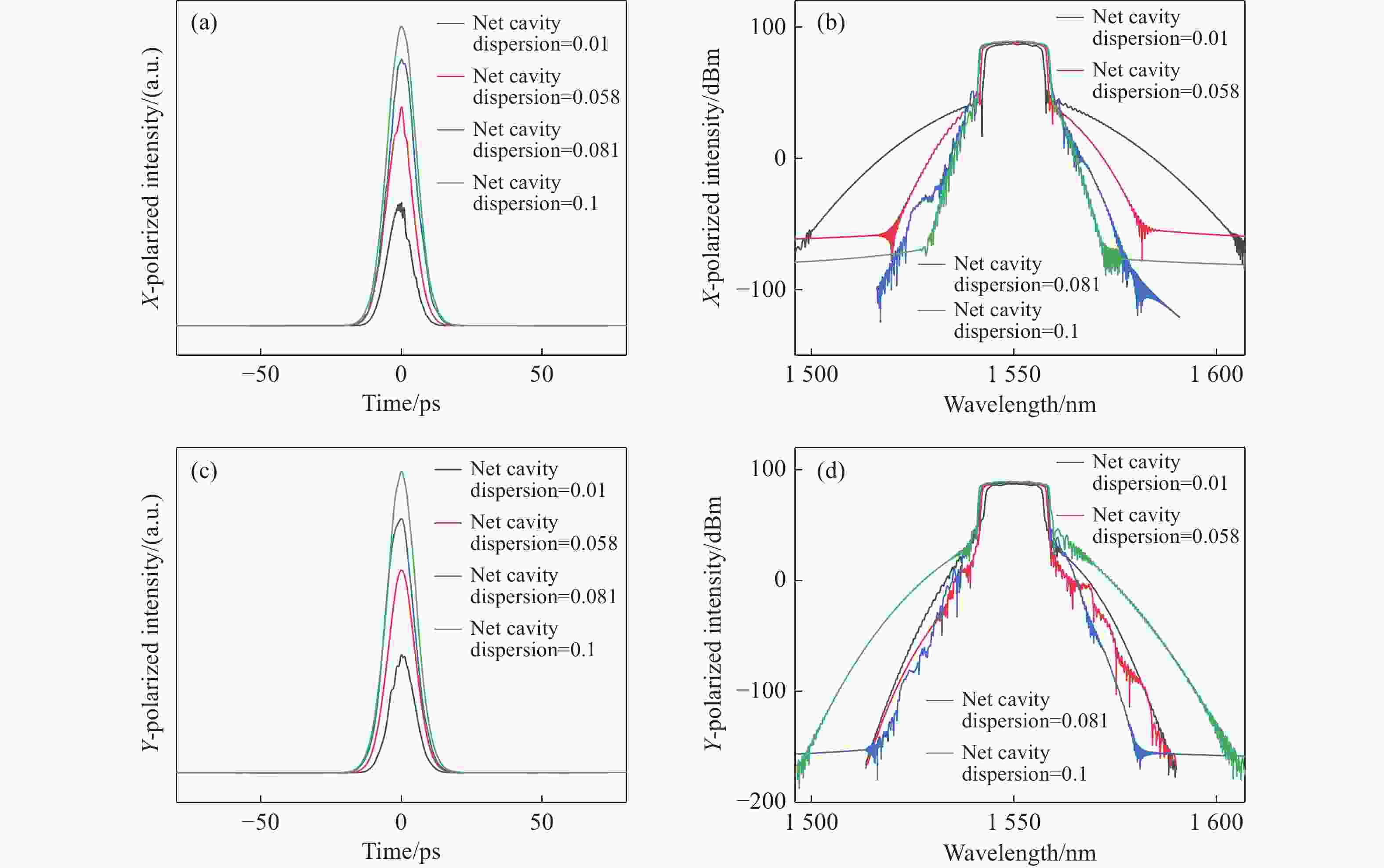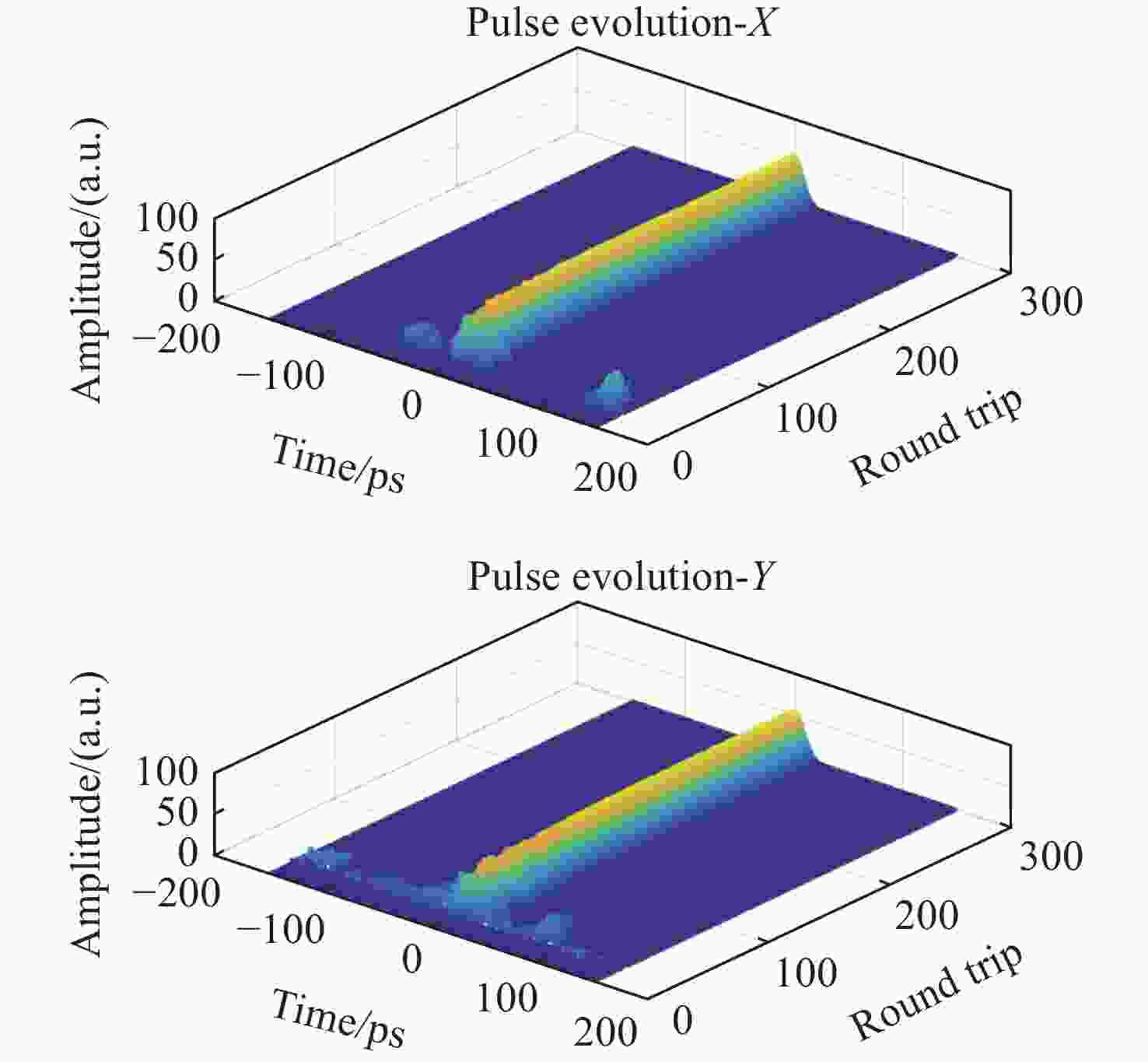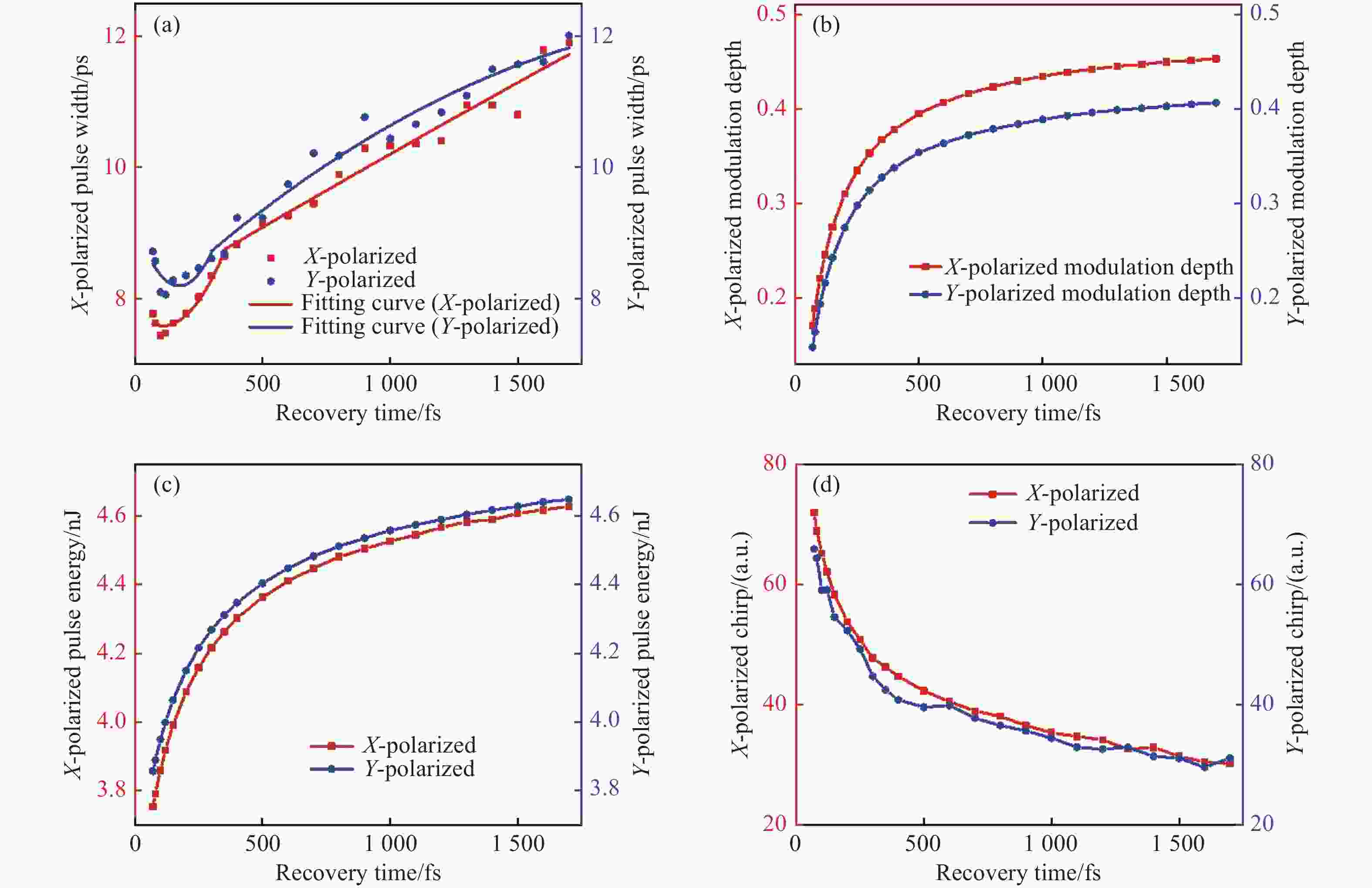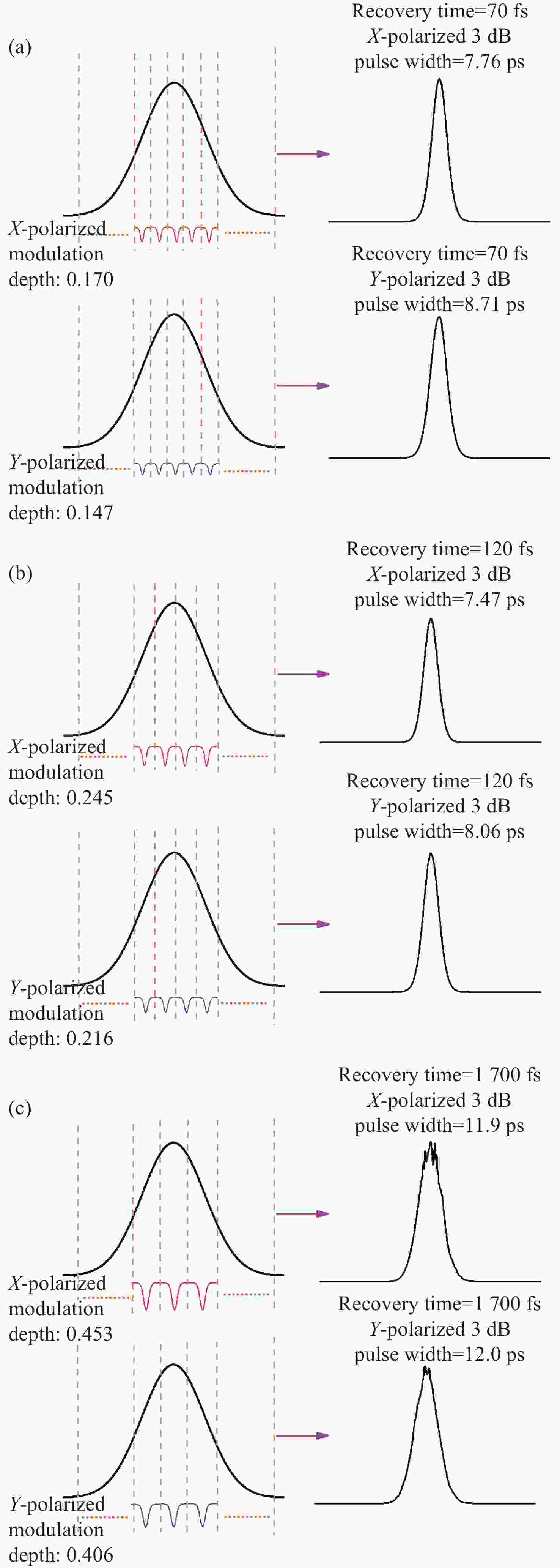Influence of SA recovery time on orthogonally polarized dissipative solitons
doi: 10.37188/CO.EN-2023-0032
-
摘要:
偏振在脉冲锁模时,对其塑形和稳定起着至关重要的作用。本研究开发了一种用于产生正交偏振耗散孤子的被动锁模石墨烯光纤激光器的正交偏振数值模拟。重点是分析由偏振依赖的石墨烯微光纤饱和吸收体引起的净正常色散双折射腔对正交偏振孤子的影响。研究结果表明,这种饱和吸收体的恢复时间显著影响正交偏振耗散脉冲的特性,如能量、脉宽、时间带宽乘积和啁啾。结果显示,其恢复时间为120飞秒时最佳,产生两个具有大啁啾的正交偏振的窄耗散孤子脉冲,分别约为7.47 ps和8.06 ps。这对于开发紧凑、高功率、偏振耗散孤子光纤激光系统具有重要意义。
Abstract:Polarization is a crucial factor in shaping and stabilizing mode-locking pulses. We develop an orthogonally polarized numerical modeling of passive mode-locked graphene fiber lasers for generating orthogonally polarized dissipative solitons (DSs). The focus is on analyzing the influence of orthogonal polarization in this net-normal dispersion birefringent cavity caused by the polarization-dependent graphene microfiber saturable absorber. The research results demonstrate that the recovery time of such saturable absorbers significantly affects the characteristics of the orthogonally polarized DSs’ output pulses, including energy, pulse width, time-bandwidth product, and chirps. Results show that its recovery time of 120 fs is optimal, producing two orthogonally polarized narrow dissipative soliton pulses with large chirps of about 7.47 ps and 8.06 ps. This has significant implications for the development of compact, high-power, polarized dissipative soliton fiber laser systems.
-
Key words:
- orthogonal polarization /
- passive mode-locking /
- net-normal dispersion /
- recovery time
-
Figure 4. (a) The influence of recovery time on the pulse width of the two orthogonal polarization components. (b) The effect of recovery time on the modulation depth for the two polarization directions. (c) The impact of recovery time on the output pulse energy of the two polarized pulses. (d) The effect of recovery time on the output pulse chirp in two polarization directions
Table 1. Different cavity lengths and their corresponding total net cavity dispersion
EDF
L/mSMF
L/mEntire Cavity
L/mNet Cavity
Dispersion/(ps2)2 3 5 0.01 2.8 3 5.8 0.058 3.2 3 6.2 0.081 3.55 3 6.55 0.1 Table 2. The output pulse parameters associated with different cavity lengths
Net Cavity
Dispersion
/(ps2)X-polarized
3 dB pulse
width/psY-polarized
3 dB pulse
width/psX-polarized
3 dB spectrum
width/nmY-polarized
3 dB spectrum
width/nm0.01 9.52 10.18 12.34 12.15 0.058 10.43 11.2 13.83 13.94 0.081 11.17 11.69 13.04 14.06 0.1 11.94 11.87 15.13 14.67 -
[1] CHANG G Q, WEI ZH Y. Ultrafast fiber lasers: an expanding versatile toolbox[J]. iScience, 2020, 23(5): 101101. doi: 10.1016/j.isci.2020.101101 [2] KIM J, SONG Y J. Ultralow-noise mode-locked fiber lasers and frequency combs: principles, status, and applications[J]. Advances in Optics and Photonics, 2016, 8(3): 465-540. doi: 10.1364/AOP.8.000465 [3] LI G M, YAN X H, KONG J, et al. Passive mode locking in fiber lasers due to the polarization-dependent losses[J]. Applied Optics, 2020, 59(33): 10201-10206. doi: 10.1364/AO.411932 [4] MA CH Y, GAO B, WU G, et al. Observation of dissipative bright soliton and dark soliton in an all-normal dispersion fiber laser[J]. International Journal of Optics, 2016, 2016: 3946525. [5] LI X, WANG D N, HUA K, et al. Saturable absorber based on graphene for a hybrid passive mode-locked erbium-doped fiber laser[J]. Optical Fiber Technology, 2022, 70: 102867. doi: 10.1016/j.yofte.2022.102867 [6] TANG P H, LUO M L, ZHAO T, et al. Generation of noise-like pulses and soliton rains in a graphene mode-locked erbium-doped fiber ring laser[J]. Frontiers of Information Technology & Electronic Engineering, 2021, 22(3): 303-311. [7] SALAM S, AL-MASOODI A H H, YASIN M, et al. Soliton mode-locked Er-doped fiber laser by using AlQ3 saturable absorber[J]. Optics & Laser Technology, 2020, 123: 105893. [8] HUI ZH Q, BU X F, WANG Y H, et al. Bi2O2Te nanosheets saturable absorber-based passive mode-locked fiber laser: from soliton molecules to harmonic soliton[J]. Advanced Optical Materials, 2022, 10(24): 2201812. doi: 10.1002/adom.202201812 [9] HUANG W CH, HU L P, TANG Y F, et al. Recent advances in functional 2D MXene-based nanostructures for next-generation devices[J]. Advanced Functional Materials, 2020, 30(49): 2005223. doi: 10.1002/adfm.202005223 [10] WANG M K, ZI Y, ZHU J, et al. Construction of super-hydrophobic PDMS@MOF@Cu mesh for reduced drag, anti-fouling and self-cleaning towards marine vehicle applications[J]. Chemical Engineering Journal, 2021, 417: 129265. doi: 10.1016/j.cej.2021.129265 [11] HUANG W CH, ZHU J, WANG M K, et al. Emerging mono-elemental bismuth nanostructures: controlled synthesis and their versatile applications[J]. Advanced Functional Materials, 2021, 31(10): 2007584. doi: 10.1002/adfm.202007584 [12] WANG M K, ZHU J, ZI Y, et al. 3D MXene sponge: facile synthesis, excellent hydrophobicity, and high photothermal efficiency for waste oil collection and purification[J]. ACS Applied Materials & Interfaces, 2021, 13(39): 47302-47312. [13] HUANG W CH, WANG M M, HU L P, et al. Recent advances in semiconducting monoelemental selenium nanostructures for device applications[J]. Advanced Functional Materials, 2020, 30(42): 2003301. doi: 10.1002/adfm.202003301 [14] HUANG W CH, ZHANG Y, YOU Q, et al. Enhanced photodetection properties of tellurium@selenium roll-to-roll nanotube heterojunctions[J]. Small, 2019, 15(23): 1900902. doi: 10.1002/smll.201900902 [15] KIM D, PARK N H, LEE H, et al. Graphene-based saturable absorber and mode-locked laser behaviors under gamma-ray radiation[J]. Photonics Research, 2019, 7(7): 742-747. doi: 10.1364/PRJ.7.000742 [16] SUN ZH P, HASAN T, TORRISI F, et al. Graphene mode-locked ultrafast laser[J]. ACS Nano, 2010, 4(2): 803-810. doi: 10.1021/nn901703e [17] CAO T, LIU SH ZH, GUO Z Y, et al. Quantification of dissipative effects in a complex Ginzburg-Landau equation governed laser system by tracing soliton dynamics[J]. Opt Express, 2023, 31(3): 4055-4066. doi: 10.1364/OE.476083 [18] CABASSE A, ORTAÇ B, MARTEL G, et al. Dissipative solitons in a passively mode-lock Er-doped fiber with strong normal dispersion[J]. Optics Express, 2008, 16(23): 19322-19329. [19] SONG Y F, SHI X J, WU CH F, et al. Recent progress of study on optical solitons in fiber lasers[J]. Applied Physics Reviews, 2019, 6(2): 021313. doi: 10.1063/1.5091811 [20] LIU X J, HU P, LIU Y, et al. Conventional solitons and bound-state solitons in an erbium-doped fiber laser mode-locked by TiSe2-based saturable absorber[J]. Nanotechnology, 2020, 31(36): 365202. doi: 10.1088/1361-6528/ab8fe6 [21] ZHANG H, TANG D Y, ZHAO L M, et al. Vector dissipative solitons in graphene mode locked fiber lasers[J]. Optics Communications, 2010, 283(17): 3334-3338. doi: 10.1016/j.optcom.2010.04.064 [22] DUDLEY J M, DIAS F, ERKINTALO M, et al. Instabilities, breathers and rogue waves in optics[J]. Nature Photonics, 2014, 8(10): 755-764. doi: 10.1038/nphoton.2014.220 [23] LECAPLAIN C, GRELU P, SOTO-CRESPO J M, et al. Dissipative rogue waves generated by chaotic pulse bunching in a mode-locked laser[J]. Physical Review Letters, 2012, 108(23): 233901. doi: 10.1103/PhysRevLett.108.233901 [24] RENNINGER W H, CHONG A, WISE F W. Dissipative solitons in normal-dispersion fiber lasers[J]. Physical Review A, 2008, 77(2): 023814. doi: 10.1103/PhysRevA.77.023814 [25] LAN H W, CHEN F L, WANG Y T, et al. Polarization dynamics of vector solitons in a fiber laser[J]. Optics Express, 2023, 31(13): 21452-21463. doi: 10.1364/OE.488504 [26] LEE J, KWON S, ZHAO L M, et al. Investigation into the impact of the recovery time of a saturable absorber for stable dissipative soliton generation in Yb-doped fiber lasers[J]. Optics Express, 2021, 29(14): 21978-21991. doi: 10.1364/OE.428462 [27] XU SH T, TURNALI A, SANDER M Y. Group-velocity-locked vector solitons and dissipative solitons in a single fiber laser with net-anomalous dispersion[J]. Scientific Reports, 2022, 12(1): 6841. doi: 10.1038/s41598-022-10818-4 [28] ZHAO L M. Vector Dissipative Solitons[M]//FERREIRA M F S. Dissipative Optical Solitons. Cham: Springer, 2022: 105-130. [29] YAN R B, HE X Y, ZHANG CH, et al. SSFM-global-error-local-energy method for improving computational efficiency of passively mode-locked fiber laser[J]. Chinese Optics, 2023, 16(3): 733-742. (in Chinese). doi: 10.37188/CO.EN.2022-0016 [30] HE X Y, WANG D N, LIU ZH B. Pulse-width tuning in a passively mode-locked fiber laser with graphene saturable absorber[J] IEEE Photonics Technology Letters, 2014, 26(4): 360-363. [31] LIU X M. Pulse evolution without wave breaking in a strongly dissipative-dispersive laser system[J]. Physical Review A, 2010, 81(5): 053819. doi: 10.1103/PhysRevA.81.053819 [32] LEE J, KWON S, LEE J H. Numerical investigation of the impact of the saturable absorber recovery time on the mode-locking performance of fiber lasers[J]. Journal of Lightwave Technology, 2020, 38(15): 4124-4132. doi: 10.1109/JLT.2020.2985718 [33] LI D J, TANG D Y, ZHAO L M, et al. Mechanism of dissipative-soliton-resonance generation in passively mode-locked all-normal-dispersion fiber lasers[J]. Journal of Lightwave Technology, 2015, 33(18): 3781-3787. doi: 10.1109/JLT.2015.2449874 [34] QIN T. The development of the electric PZT extrude fiber polarization controller[D]. Beijing: Beijing Jiaotong University, 2014. (in Chinese). [35] HAN D D, ZHANG J Y, REN K L, et al. Real-time measurement of fission dynamics of dissipative soliton[J]. Acta Optica Sinica, 2022, 42(7): 0706001. (in Chinese). doi: 10.3788/AOS202242.0706001 [36] DAWLATY J M, SHIVARAMAN S, CHANDRASHEKHAR M, et al. Measurement of ultrafast carrier dynamics in epitaxial graphene[J]. Applied Physics Letters, 2008, 92(4): 042116. doi: 10.1063/1.2837539 [37] BREUSING M, ROPERS C, ELSAESSER T. Ultrafast carrier dynamics in graphite[J]. Physical Review Letters, 2009, 102(8): 086809. doi: 10.1103/PhysRevLett.102.086809 [38] SUN Z, HASAN T, FERRARI A C. Ultrafast lasers mode-locked by nanotubes and graphene[J]. Physica E:Low-dimensional Systems and Nanostructures, 2012, 44(6): 1082-1091. doi: 10.1016/j.physe.2012.01.012 -





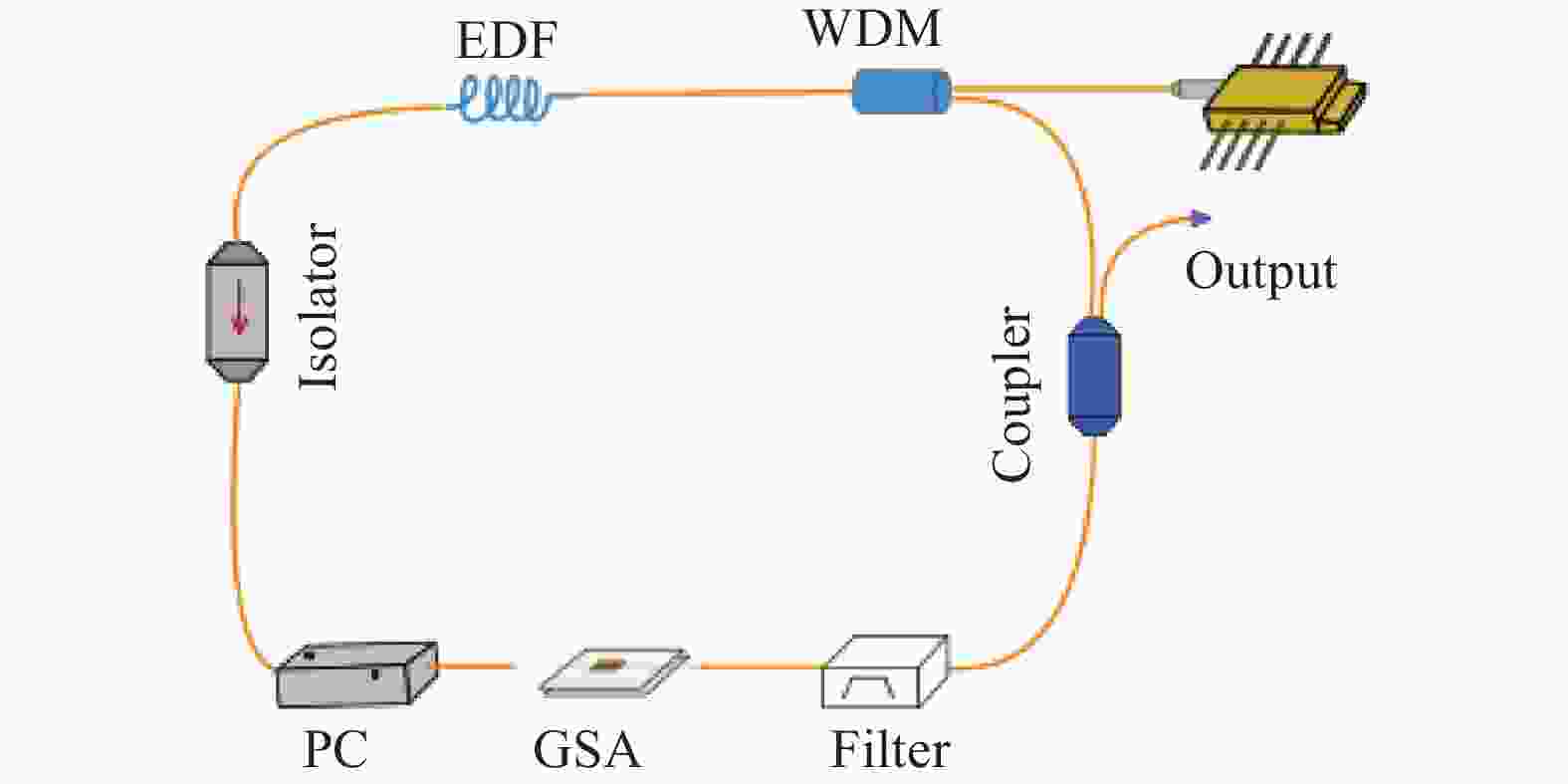
 下载:
下载:
